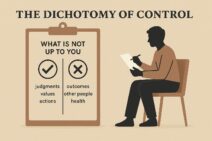Stoic Practices: The Dichotomy of Control
The Dichotomy of Control is one of the most practical and enduring ideas in Stoicism. Epictetus called it the “fundamental rule.” Marcus Aurelius relied on it while leading an empire through war, plague, and political unrest. It is deceptively simple: some things are up to you, and some things are not.
Your judgments, your values, your actions are yours. The outcome, other people’s choices, luck, health, and politics are not.
It sounds obvious, but in daily life, the line between these two is often blurred. We often find ourselves worrying about what we cannot change. We spend energy on what belongs to someone else’s decision. We ignore the actions that are ours to take. I have done this many times, and the lesson has had to be learned more than once.
In September 2023, I began a program with my physician assistant to dramatically improve my health. The plan was not easy. It required consistent effort, discipline in eating, and daily movement. Over the months that followed, I lost more than 180 pounds. I reversed prediabetes. My liver function improved to the point that my PA called it “excellent,” and the Cardiologist referred to it as “remarkable.” Every bit of that progress came from choices I could control: what I ate, how much I moved, how faithfully I followed medical advice, and how often I checked my progress.
But there is another truth I cannot escape. At my age, even in the best health of my life, I have more years behind me than ahead. That is not defeatist. It is reality. My choices can influence the quality of the years ahead, but not their number. The clock is always moving, and no one can slow it. This is the heart of the Dichotomy of Control. Act fully where you can. Accept what you cannot change.
I wish I had applied that same clarity last month when I was warned about a possible layoff tied to DOGE funding decisions. The warning came early enough to act. I took some steps toward finding another position, while also pouring a great deal of energy into making myself more valuable to the company. I convinced myself that if I could demonstrate my worth, it might shield me from the layoff.
What I did not want to admit at the time was that no amount of extra effort on my part could speed the flow of federal dollars or reverse the cuts being planned. Those decisions were entirely outside my control. Updating my résumé, reaching out to my network, and applying for new positions belonged on my side of the line. Trying to offset a federal budget shortfall did not. Every hour spent on the latter was an hour I could have invested in the former.
 Marcus Aurelius understood this distinction. During the Antonine Plague, which killed millions, he did not waste time wishing the disease would vanish. He sold imperial treasures to fund relief. That was a practical step within his power. The rest he accepted. The Stoic approach was not to stand idle. It was to act where action was possible and to let go of the rest.
Marcus Aurelius understood this distinction. During the Antonine Plague, which killed millions, he did not waste time wishing the disease would vanish. He sold imperial treasures to fund relief. That was a practical step within his power. The rest he accepted. The Stoic approach was not to stand idle. It was to act where action was possible and to let go of the rest.
I have to remind myself that this principle applies even in small, everyday moments. Massimo Pigliucci once let minor irritations ruin his day. A glowing phone screen in a dark theater. Loud music on a subway car. His habit then was to stew in frustration. Now he asks himself a simple question: Is this up to me? If yes, he acts. If not, he lets it go. Complaining without action only makes the injury worse.
The Dichotomy of Control works best when it is made deliberate. That means turning it into a habit.
The Dichotomy of Control is not about resignation. It is about effectiveness.
A simple daily practice
- Draw two columns. On the left, list what is within your control. On the right, list what is not.
- Circle one item in the left column and take a concrete action on it today.
- Cross out the right column as a visual signal that you will stop spending time or energy there.
- Review at the end of the day. Where did you stay on your side of the line? Where did you cross it?
 When I apply this exercise, the fog clears. In the layoff situation, my left column should have been filled with résumés sent, contacts called, and job applications completed. My right column should have contained federal appropriations, agency spending decisions, and the company’s contract portfolio. Acting from the left column would not have guaranteed a job, but it would have used my time where it mattered most.
When I apply this exercise, the fog clears. In the layoff situation, my left column should have been filled with résumés sent, contacts called, and job applications completed. My right column should have contained federal appropriations, agency spending decisions, and the company’s contract portfolio. Acting from the left column would not have guaranteed a job, but it would have used my time where it mattered most.
The Dichotomy of Control is not about resignation. It is about effectiveness. It is about refusing to spend your limited energy on walls that will never move, and choosing instead to push where something can shift. It is also about perspective. My health journey is proof that effort matters. My job loss serves as a reminder that results are never guaranteed.
There is also a more profound peace that comes from drawing that line clearly.
You no longer have to carry the weight of the whole world. You carry your part of it. That is enough.
In the end, the Dichotomy of Control is a choice. You can spend your life trying to force the world into your shape, or you can work skillfully with the part of it that has always been yours: your mind, your actions, and your character. The rest will do what it will do.
My health journey is proof. My job loss is the reminder. Both teach the same lesson. The choice is mine. The result never was.
